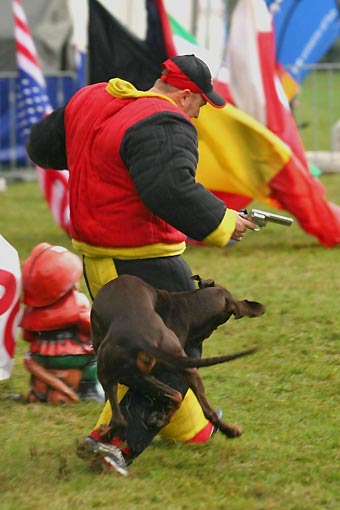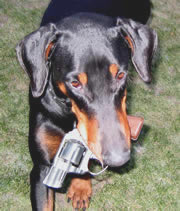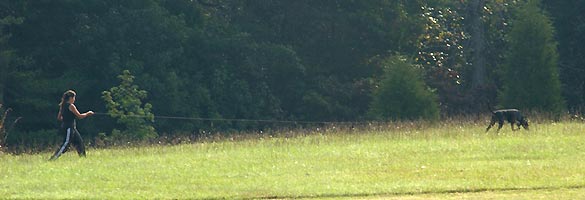A number of European countries established their own mode of selecting working dogs for use in the police and military around the turn of the century. The inclusion of civilians handling and titling dogs in these programs broadened the selection choice. KNPV which is the Royal Dutch Police Dog Association was formed in 1907 and has about 10,000 members currently. There are five different titles: Police Dog 1 (PH 1), Police Dog 2 (PH 2), tracking dog, object guarding dog and search and rescue dog. The PH 1 is the most commonly sought title. The government demands this certification for police dogs and dogs used by security companies.
The Dansk Politihundeforening (DPH) or Danish Police Dog Association was established in 1909. Members are either Police Service Dog Handlers (referred to as Section 1), or either Police Officers with private dogs or civilian people training dogs (Section II) The first test, the PH Kåring, may be taken when the dog is 12 months old which shows the level of maturity expected of a working dog. The test includes obedience heeling, retrieving of a wooden dowel, climbing over a 1.5 meter high fence with automatic finish position beside the handler, barking on command, and a long down and recall to the hidden handler. The dog must locate the start of a track between stakes placed 7 meters apart and then dutifully follow a half hour aged, no less than 250 meter track and either indicate or retrieve an object at the end.
Rondering involves directed searching and locating a hidden person followed by a hold and bark guard that allows the handler to find his dog. The barking for location is necessary because the dog is working in a forest area that is at least 75 x 250 meters. The subject does not wear any bite protective equipment, so the dog must not cause any harm. Bite work involves two exercises: an agitator attacks the dog, firing a gun at close range as the dog approaches him. The dog must show a convincing attack and solid grip throughout, until the disarm of the agitator is accomplished by the handler and the dog is called to out. The second attack is with a stick threat, and the dog is hit by the agitator. Failure in Rondering, Tracking or Bitework (failure to engage or to out) constitutes failure of the trial. For a Police Service Dog, there are two additional bite work exercises: a defence of handler and a call off from a bite.

‘Ascomannis Gringo' BH, Mondioring 3, Security Dog
The decoy is armed with a revolver and will fire two shots while the dog is biting in the ‘Flee Attack'. Biting under gunfire is another exercise that was part of Schutzhund many years ago. Today, the attack under gunfire is retained in French Ring, Mondioring, KNPV, and the Danish Police Dog Program amongst others.
There are three further levels of titling and competition in the DPH program with increasing difficulty: Young Dog Class, Criminal Class and Winner's Class. An evidence search for small items is added in the Young Dog Class which takes place in a marked 10 meter x 10 meter square. Additionally, the track is aged an hour and rondering is not only to locate a person, but also two evidence objects. Objects for the obedience retrieval are no longer just a wooden dowel but may be a multitude of objects-- a hammer, a frying pan, a screwdriver, even a pistol. By Winner's Class, the evidence search is conducted in a 25 meter x 25 meter square with items less than 2 cm x 2 cm in size and it has been aged at least 4 hours. The track begins between two markers 25 meters x 25 meters apart and is at least 1000

Image left Ascomannis Fenya, PH Kåring retrieving a pistol.
Image below - Some items from an Evidence Search


‘Ascomannis Gina' BH, VPG 2, FH 2, PH Kåring tracking for her FH 1 in a Schutzhund trial.
This track is at least 1200 paces long and 3 hours old. It has 6 ninety degree corners, 4 articles left by the tracklayer, along with cross-tracks laid by a second person that intersect the original track at least twice. The FH1 has many similarities to tracks in the higher levels of DPH except for one major difference. A Schutzhund track begins beside a stake set in the ground. In DPH Winner's Class tracking, the dog must find the beginning of the track.



